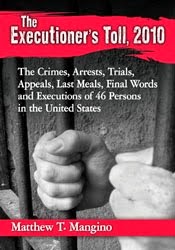The 17th Execution of 2022
Kevin Johnson – who murdered a Kirkwood, Missouri,
police officer in 2005 but claimed racial bias in his prosecution – was
executed on November 29, 2020 by lethal injection, reported CNN.
Johnson, 37, was pronounced dead at 7:40 p.m. CT. He
didn’t give a final statement, according to Missouri Department of Corrections
spokesperson Karen Pojmann.
The execution went ahead after the US Supreme Court
denied his request for a stay of execution. Justices Ketanji Brown Jackson and
Sonia Sotomayor dissented, according to the court’s website.
On Monday, the Missouri Supreme Court had denied
Johnson’s request for a stay after hearing arguments that racial discrimination
played a role in his prosecution.
Mary McEntee, the widow of Kirkwood Police Sgt.
William McEntee, said her husband was killed on his hands and knees in front of
people he dedicated his life to serve.
“When he left for work that day, we could not
imagine that he would be executed by someone he gave his life to protect,” she
said at a media briefing Tuesday evening. “Bill didn’t get to fight for his
life. He didn’t have the chance to be heard before a jury, to decide whether he
would live or die.”
She also thanked the prosecutors who put in the
“hard work and endless hours … for justice for Bill.”
The execution was not witnessed by Johnson’s
19-year-old daughter, who had failed this month to get a federal court to prevent
the state from executing her father unless she was permitted to be a witness.
Missouri law bars people younger than 21 from witnessing the proceeding.
On Monday, the Missouri Supreme Court heard arguments in two requests for a stay: one by Johnson, who was Black, and the other by a special prosecutor appointed at the request of the St. Louis County Prosecuting Attorney’s Office, which secured Johnson’s conviction on a first-degree murder charge and death sentence for the murder of McEntee.
Both requests sought a stay so claims of racial
prejudice could be heard by the St. Louis County Circuit Court, which
previously denied a motion by the special prosecutor to vacate Johnson’s
conviction, saying there was not enough time before Johnson’s scheduled
execution to hold a hearing.
“There simply is nothing here that Johnson has not
raised (and that this Court has not rejected) before and, even if there were,
Johnson offers no basis for raising any new or re-packaged versions of these
oft-rejected claims at this late date,” the Monday ruling said.
“Mr. Johnson has received every protection afforded by the Missouri and United States Constitutions, and Mr. Johnson’s conviction and sentence remain for his horrendous and callous crime,” Parson said in a statement. “The State of Missouri will carry out Mr. Johnson’s sentence according to the Court’s order and deliver justice.”
A defense attorney for Johnson decried Monday’s
state Supreme Court ruling as a “complete disregard for the law in this case.”
“The Prosecutor in this case had requested that the
Court stop the execution based on the compelling evidence he uncovered this
past month establishing that Mr. Johnson was sentenced to death because he is
Black,” lawyer Shawn Nolan said in a statement. “The Missouri Supreme Court
unconscionably refused to simply pause Mr. Johnson’s execution date so that the
Prosecutor could present this evidence to the lower court, who refused to
consider it in the first instance given the press of time.”
Meantime, attorneys for Johnson argued in court records that racial discrimination played a role in his prosecution, pointing in their motion for a stay to “long-standing and pervasive racial bias” in St. Louis County prosecutors’ “handling of this case and other death-eligible prosecutions, including the office’s decisions of which offense to charge, which penalty to seek, and which jurors to strike.”
Per their request, the prosecuting attorney sought
the death penalty against four of five defendants tried for the killing of a
police officer while in office – all of them Black, while the fifth was White.
In the case with a White defendant, Johnson’s request says, the prosecutor
invited defense attorneys to submit mitigation evidence that might persuade the
office not to seek death – an opportunity not afforded the Black defendants.
Additionally, they pointed to a study by a University of North Carolina political scientist of 408 death-eligible homicide prosecutions during
this prosecutor’s tenure that found the office largely sought the death penalty
when the victims were White.
Those claims appear supported by a special
prosecutor, who was appointed to the case last month after the St. Louis
Prosecuting Attorney’s Office cited a conflict of interest. The special
prosecutor, Edward E.E. Keenan, similarly “determined that racist prosecution
techniques infected Mr. Johnson’s conviction and death sentence,” he wrote in
his own request for a stay.
The special prosecutor found “clear and convincing
evidence of racial bias by the trial prosecutor,” he wrote in the request,
citing similar evidence to that listed by Johnson’s attorneys in their request
for a stay.
The Missouri Attorney General’s Office argued
against a stay, saying the claims were without merit. The special prosecutor’s
“unproven claims,” the AG’s office said in a brief, do not amount to a
concession of wrongdoing by the state, which stands by the conviction.
“The McEntee family has waited long enough for
justice,” the brief said, “and every day longer that they must wait is a day
they are denied the chance to finally make peace with their loss.”
Bob McCulloch, the longtime St. Louis prosecuting
attorney who was voted out of office in 2018 after 27 years, has denied he
treated Black and White defendants differently.
“Show me a similar case where the victim was Black
and I didn’t ask for death,” he was quoted as saying by St. Louis Public Radio earlier this month about
his time in office. “And then we have something to talk about. But that case just
doesn’t exist.”
Johnson was sentenced to die for the July 5, 2005,
murder of McEntee, 43, who was called to Johnson’s neighborhood in response to
a report of fireworks.
Earlier that day, Johnson’s 12-year-old brother had
died after having a seizure at their family’s home, according to court records.
Police were there at the time of the seizure, seeking to serve a warrant
against Johnson, then 19, for a probation violation.
Johnson blamed the police, including McEntee, for
his brother’s death. And when McEntee returned to the neighborhood later that
day, Johnson approached the sergeant’s patrol car, accused him of killing his
brother and opened fire.
He left behind a wife, a daughter and two
sons, according to the Officer Down Memorial Page.
To read more CLICK HERE











